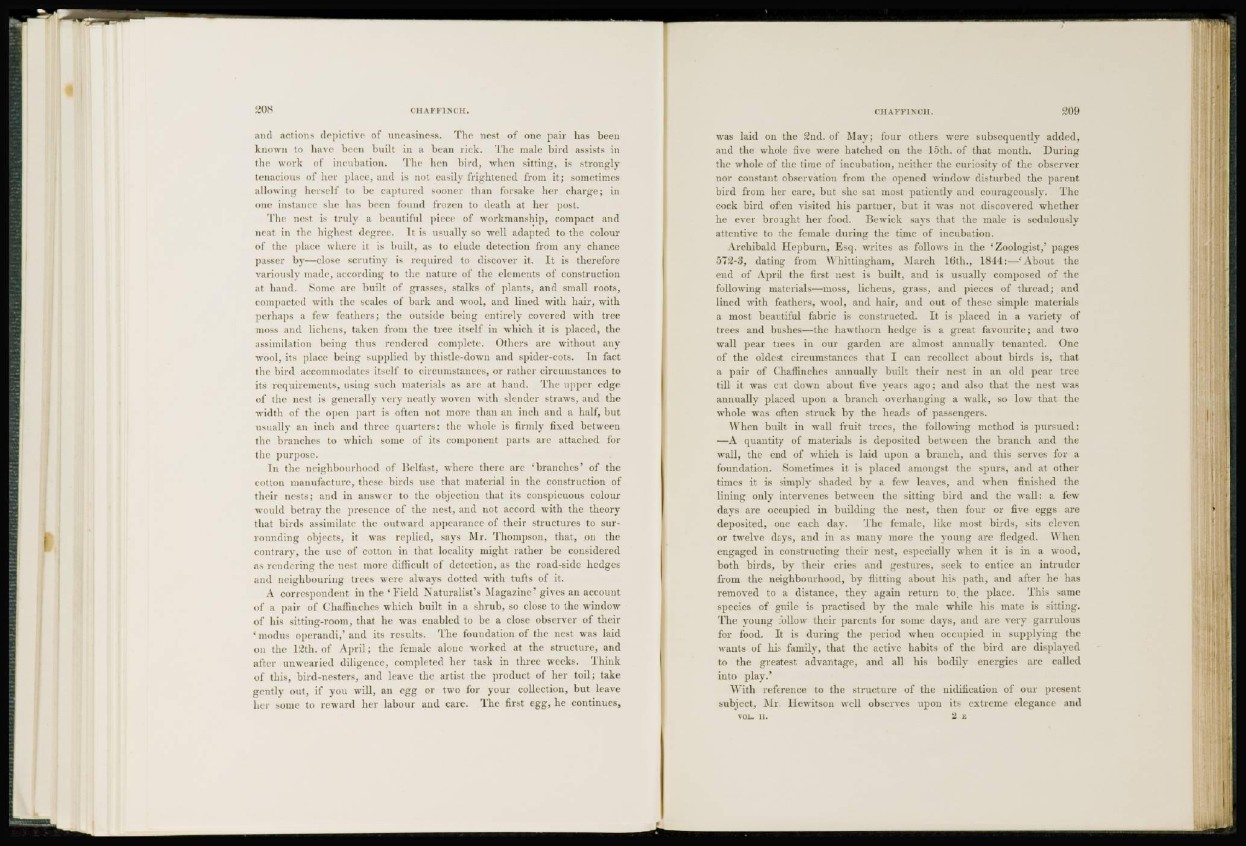
208 CHAFFINCH.
and actions depictive of uneasiness. The nest of one pair has been
known to have been built in a bean rick. The male bird assists in
the work of incubation. The lien bird, when sitting, is strongly
tenacious of her place, and is not easily frightened from it; sometimes
allowing herself to be captured sooner than forsake her charge; in
one instance she has been found frozen to death at her post.
The nest is truly a beautiful piece of workmanship, compact and
iK ;il in the highest degree. It is usually so well adapted to the colour
of the place where it is built, as to elude detection from any chance
p.isser by—close scrutiny is required to discover it. It is therefore
variously made, according to the nature of the elements of construction
at hand. Some are built of grasses, stalks of plants, and small roots,
compacted with the scales of bark and wool, and lined with hair, with
perhaps a few feathers; the outside; being entirely covered with tree
moss and lichens, taken from the tree itself in which it is placed, the
ussimihition being thus rendered complete. Others arc without any
wool, its place being supplied by thistle-down and spidcr-cots. In fact
the bird accommodates itself to circumstances, or rather circumstances to
its requirements, using such materials as are at hand. The upper edge
of the nest is generally very neatly woven with slender straws, and the
width of the open part is often not more than an inch and a hall', but
usually an inch and three quarters: the whole is firmly fixed between
the branches to which some of its component parts are attached for
the purpose.
In the neighbourhood of Belfast, where there are 'branches' of the
cotton manufacture, these birds use that material in the construction of
their nests; and in answer to the objection that its conspicuous colour
would betrav the presence of the nest, and not accord with the theory
that birds assimilate the outward appearance of their structures to surrounding
objects, it was replied, says Mr. Thompson, that, on the
contrary, the use of cotton in that locality might rather be considered
as rendering the nest more difficult of detection, as the road-side hedges
and neighbouring trees were always dotted with tufts of it.
A correspondent in the 'Field Naturalist's Magazine' gives an account
of a pair of Chaffinches wdiich built in a shrub, so close to the window
of his sitting-room, that he was enabled to be a close observer of their
' modus operandi,' and its results. The foundation of the nest was laid
on the 12th. of April; the female alone worked at the structure, and
after unwearied diligence, completed her task in three weeks. Think
of this, bird-nesters, and leave the artist the product of her toil; take
gently out, if you will, an egg or two for your collection, but leave
her some to reward her labour and care. The first egg, he continues,
e n M'FIM n . 209
was laid on the 2nd. of May; four others were subsequently added,
and the whole five were hatched on the 15th. of that month. During
the whole of the time of incubation, neither the curiosity of the observer
nor constant observation from the opened window disturbed the parent
bird from her care, but she sat most patiently and courageously. The
cock bird often visited his partner, but it was not discovered whether
he ever brought her food. Bewick says that the male is sedulously
attentive to the female during the time of incubation.
Archibald Hepburn, Esq. writes as follows in the 'Zoologist,' pages
572-3, dating from Whittingham, March 16th., 1844:—'About the
end of April the first nest is built, and is usually eonvposed of the
following materials—moss, lichens, grass, and pieces of thread; and
lined with feathers, wool, and hair, and out of these simple materials
a most beautiful fabric is constructed. It is placed in a variety of
trees and bushes—the hawthorn hedge is a great favourite; and two
wall pear trees in our garden are almost annually tenanted. One
of the oldest circumstances that I can recollect about birds is, that
a pair of Chaffinches annually built their nest in an old pear tree
till it was cut down about five years ago; and also that the nest was
annually placed upon a branch overhanging a walk, so low that the
whole was often struck by the heads of passengers.
When built in wall fruit trees, the following method is pursued:
—A quantity of materials is deposited between the branch and the
wall, the end of which is laid upon a branch, and this serves for a
foundation. Sometimes it is placed amongst the spurs, and at other
times it is simply shaded by a few leaves, and when finished the
lining only intervenes between the sitting bird and the wall: a few
days are occupied in building the nest, then four or five eggs are
deposited, one each day. The female, like most birds, sits eleven
or twelve days, and in as many more the voung arc fledged. \\ hen
engaged in constructing their nest, especially when it is in a wood,
both birds, by their cries and gestures, seek to entice an intruder
from the neighbourhood, by flitting about his path, and after he has
removed to a distance, they again return to. the place. This same
species of guile is practised by the male while his mate is sitting.
The young follow their parents for some days, and arc very garrulous
for food. It is during the period when occupied in supplying the
wants of his family, that the active habits of the bird are displayed
to the greatest advantage, and all his bodily energies are called
into play.'
With reference to the structure of the nidification of our present
subject, Mr. Hewitson well observes upon its extreme elegance and
VOL. ii. 2 a.